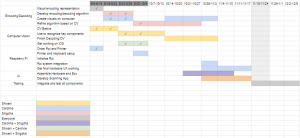This week’s main goal was to continue integrating the different aspects of our project together. Shivani and Snigdha were able to integrate the image scanning and processing with the decoding algorithm and Caroline was able get the keyboard and printer integrated to the Raspberry Pis. We also started brainstorming about different ways we can make our pattern more complex and aesthetically pleasing.
Caroline
This week I integrated more of our end-to-end sender system on the first Raspberry Pi. Now, typing a message into a keyboard and hitting the button prints out the message automatically. There are two big things I am planning to get done this coming week: (1) hooking up the Raspberry Pi camera to a button on the second Pi, and (2) working to integrate the automatic printing with Snigdha’s encoding code. The biggest challenge here is that the encoding is happening in p5.js, which is browser-based, and does not have an easy way to interact with the command line for automatic printing. My starting point here will be using web sockets to communicate the keyboard input to the encoding algorithm, and then somehow sending the image to the printer, either by saving the image and running command line code, or by hosting the image on a local server and having some other command line code reach out and print it.
Snigdha
This week, I worked with Shivani and Caroline to figure out how to further beautify our encryption. More specifically, we looked at ways that the encryption could be modified to look more visually pleasing and complicated beyond rows of shapes. We also looked at other ways we can encrypt the message before displaying it, or ways to alter the visuals to further obfuscate the message. These are still topics that need a bit more research before we can begin implementing them. Additionally, I continued working with Shivani to integrate the CV with the decryption, as well as talking with Caroline about the encryption and how to intergrate it with hardware.
Shivani
This week, I worked with Snigdha on connecting the computer vision and decoding parts together. I did a lot of testing to ensure that the order that the image was scanned was correct and that the colors are easily scanned. During class on Wednesday, I started looking into getting OpenCV set up on the other Raspberry Pi and porting our scanning mechanism there. For next week, I plan on working with Caroline to continue the set up process for the Raspberry Pi and do more testing using that camera to make sure that everything is able to scan.


